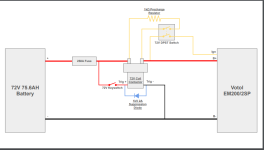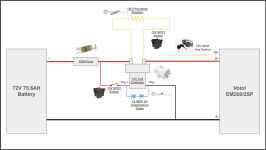harrisonpatm
10 kW
- Joined
- Aug 8, 2022
- Messages
- 836
Hm, I might have to disagree with you on a few points. I don't think any of your points are inherently wrong: it's true that most BMSs are able to protect against overcurrent, turn on/off. But some of them do that with different levels of difficulty and/or interfaces. For example, I know that your ANT BMS does have a physical on/off button. But JKBMS doesn't, you can only access that function via an app. Others may not have a button either. And BMS with a precharge? That's actually cool, I haven't seen or heard of that before, I'll have to keep my eye out. But again, that means not all BMSs have that function.As for precharge, breaker and all that stuff, I suggest not bothering yourself with it.
It only will add more weight, more complexity and more failure points, for no added value. A smart BMS will do all of that already, because a BMS is basically a breaker (it monitors current and you can tell it to cut power if it goes over any level of your choice) and a contactor (the BMS can cut off the power completely either with a long press on a physical button, or in the phone app by clicking on a button), and smart BMSs include a precharge system which even allows you to set and change the precharge current to whatever value you want in just a few clicks in the app.
Also if something is damaged the BMS can detect it and it will cut power/beep at you.
So there's really no need to double down on this. In my opinion the only thing you should really add to a BMS is a good fuse between the BMS and the battery. In case the BMS goes wrong the fuse will be there to cut the power and it'll protect the battery from damage.
All that contactor/precharge/breaker stuff made sense a long time ago, but theyre completely outdated now that we got decent and cheap smart BMS.
If/when they do have all the above functions, most of the time their interface is mainly via an app. Some people prefer not to have to use their phone for everything, and like to have physical and analog interfaces (I just started a whole different thread about how I'd rather teach myself how to mod a physical analog voltmeter for my desired range, rather than rely on an LCD screen with a simulated dial gauge). It's not always about distrust of programming or computers. When I need to go work on some of the cabling on my bike, or pull off covers and expose cables for service reasons, I'd rather have a physical switch that I can turn off, and can see with my eyes that it's in the off position, than to just trust that I remembered to turn it off with my phone. I do both, for the record.
While it's unlikely for a BMS to have a serious failure, when the FET's fail, they can fail closed and are then unable to shutoff current. It's exceedingly unlikely for a contactor to fail closed, there's a spring pushing it towards open position. I suppose the only way for it to fail closed would be for the contacts to weld together. Which is why I recommended a contactor way way overrated for OP's use, at 900vdc and 500A capability, for his 72v/200A capable system. In addition, depending on exactly what parts were used to build a BMS, turning off output voltage may still cause some voltage to leak through. I'm not an electrical engineer, I just know that when I turn off my BMS via an app, I can still get low voltage readings off my battery terminals. I'd rather see 0V.
I can't argue against your point that more elements = more failure points. But perhaps that's can be a good thing? If something is wrong with a system that causes one of you 4-5 elements between your battery and controller to fail, I'd rather catch that failure point and fix whatever the issue was, and only have broken one small element, rather than the BMS, if the BMS is your only protection (though of course you did recommend a hard fuse). It's true that there are more, cheaper BMSs available now, but "cheap" is relative, as a good BMS can be $100-300 USD, and I'd want several elements protecting that investment and helping it out. Especially since the contactor I suggested is $15, the breaker can be found for $10 or less, and a resistor for precharge could cost $0.25, if that.
As for added weight? The contactor is 450g, the breaker is 150g, a resistor is a couple grams, and we'll assume 250g for the extra copper lugs that you'll need to connect them. If someone is concerned about saving 750g on their build, you could just skip breakfast or leave your water bottle at home.
Again, I don't think you're wrong with skipping contactor/precharge/breaker. Just making sure OP is informed.



